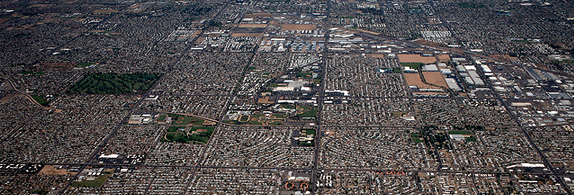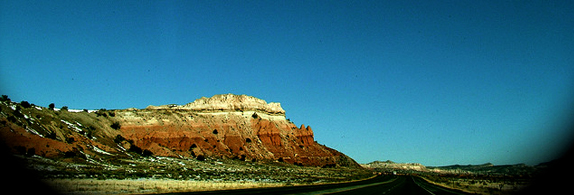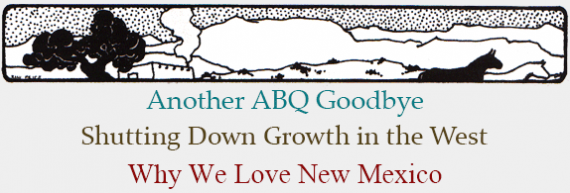Goodbye Albuquerque, A City with its Head Up its…

This sorry tradition of leaving turds on the rug as a token of disenchantment when folks leave Albuquerque or New Mexico is getting tiresome. It makes for good copy and headline writers can have a field day. But there’s always something missing.
The latest little dropping is called “Goodbye Albuquerque, Land of Violence.” It appeared in the New York Times on August 2 and was written by a Justin St. Germain who’d lived here for three years before he left “New Mexico for good.”
The trouble with this little goodbye stinker is that it’s true, if not complete.
The headline might better have read, “Goodbye Cruel Albuquerque, City of the Heartless Ostrich Bosses.”
St. Germain’s piece is well written and dead on when he described the city’s blind eye to violence against the homeless and the mentally ill. He was right when he cited the James Boyd execution and the police killing of 19 year old Mary Hawkes, and the 25 other police shootings of citizens since Mayor Richard Berry took office in December 2009. Problem is he doesn’t mention Mayor Berry, or the rest of the city’s leadership elite. I guess St. Germain wasn’t here long enough to plumb our politics.
Albuquerque has been a violent place for as long as I’ve lived here. But so are L.A., Las Vegas, and Phoenix. None of them, of course, are only violent places. Neither is Albuquerque. Those of us who love this city and have committed to it know that. We also know the violence has gotten worse over the years, especially since the Reagan administration and the shuttering of mental institutions around the country. Our income disparity started much earlier, after the Manhattan Project and the military colonization of the state created steady elite jobs and whopping salaries for some and resigned the rest of us to marginal, boom-bust employment in construction, mining, and financially disrespected intellectual work like teaching and writing and making art and dead end work and brutal poorly paid labor in the vast rural regions of the state.
In Albuquerque, as the city swelled in size, partly with refugees from areas of rural depression, the people who love the city and make good lives here simply flat out forgot that there is a connection between politics and policing, and politics and poverty, and politics and civic awareness, and politics and community, politics and responsibility, politics and heartlessness, politics and the social golden rule.
Our electorate, many of them highly educated people, went flaccid as citizens over the decades, hibernating in their occupational enclaves and failing to participate in local matters, even preferring not to know much at all about them.
It got so bad we actually re-elected Richard Berry mayor in 2013 with glad cries and the glowing endorsement of the Albuquerque Journal. But as hard as his opponent, the former prosecutor, city councilor and public safety chief Pete Dinelli tried to insert the abuses of the Albuquerque Police Department and the failure of the city to rebound from the recession of 2008 into the public discourse, he was met with yawns. And those issues were never talked about, not in print nor on the airwaves. And now we have the specter of Mayor Berry for three more dreadful years.
Most cities are ruled surreptitiously by a leadership elite and ours is no different. That elite is usually drawn from the monied and business classes and is supported by media whose revenue is fed by that elite. As many have already observed, violence against the vulnerable in Albuquerque has been a part of our urban psyche and physical reality for more than 30 years. And violence by law enforcement officers and others these last four years has been among the worst.
Not only has the electorate gone limp with only 25% of registered voters bothering to go to the polls in the last city election despite a controversial anti-abortion measure on the ballot which was roundly defeated, the mainstream media played up the record breaking early and absentee voting turnout but said little about the dismal voter apathy overall,
The leadership elite played ostrich again instead of engaging the serious issues of the day. And when it comes to bloodshed on our streets no one is taking any responsibility. The city builds instead a wall in the City Council chamber to keep “protesters” at bay. It hires out of state operatives to negotiate with the Justice Department after its withering report on unconstitutional police violence instead of our elected officials doing it themselves. They prefer to vanish almost without a trace as the mayor has done until the unpleasantness has blown over. The leadership won’t raise a whimper or a whisper over what’s being said about us around the country and the world. The power elite just spends money and energy trying to deny or weasel out of the horror show instead of trying to fix it.
How can a city run by skinflints countenance the loss of more than $30 million in civil rights law suits over unconstitutional police violence and not try to do something to stop the hemorrhaging?
The leadership elite of our city is so lazy and complacent it can’t get Albuquerque out of what the Brookings Institution has called a double dip recession and a status as the worst city in the country as far as recovering from the recession of 2008. What good are these people if they won’t get this city moving again, and get it out of the national spotlight by seriously owning up to the disgraceful history of police violence and leadership denial?
There is more to Albuquerque than it being a “land of violence.” But the do nothing, deny everything, head in the sand, butt gazing approach of our present leadership elite, including the mayor and the majority of the city council, is making it seem that Albuquerque is nothing more than a brutal, blood soaked failure.
Shutting Down Growth in the West

How do cities actually go about shrinking themselves in attempts to survive a change in fortune that deprives them of the basic needs of life? I suppose the answer to such questions is as varied as the cities themselves, each one unique, each one serving universal human needs, or not.
Would Albuquerque shut down services to its Westside if too many people left and too many houses were in foreclosure? Would the city cordon off the Southeast Heights because of the Kirtland Air Force Base jet fuel contamination of the aquifer in that region of the city?
If predictions and trends hold true, cities in the American Southwest, in California, Arizona, Nevada and New Mexico could find themselves forced to cope with a long term reversal in fortune when it comes to weather and the life giving water it brings. What happens when cities in the west lose population, slowly or in a rush, because water has become so scarce that cost and rationing has caused a localized recession with real estate and construction free falling into the dumper?
How will cities like Tucson, Phoenix, Las Vegas, and Albuquerque react when their supplies of water are greatly reduced by a combination of weather and Federal mandate? Will they do what Detroit has done? Will they shut off services to undesired parts of themselves, leave certain residents high and dry while favoring others and allowing businesses to continue to consume and consume even into bankruptcy?
As the Colorado River suffers though its 14th year of drought conditions in its multiple watersheds, the 40 million or so westerners who depend on the river are increasingly in jeopardy of having happen to them what happened to Southern Californians in 2003.
After the huge building boom throughout the l990s in Las Vegas, Southern California, and Phoenix, use of the Colorado River was stretching thin even with normal snowpacks. Arizona had grown so fast it was demanding its full allotment for the Central Arizona Project which waters Phoenix and Tucson. Trouble was California was using that water and was loath to give it up. Numerous efforts were made, under Federal supervision, to shift agricultural water to southern California cities, but no deals could be made.
So on January 1, 2003, Secretary of the Interior Gail Norton, ordered three of the eight pumps from Lake Mead be shut down, which they were at 8 a.m., depriving Los Angeles and San Diego of some 650,000 acre feet of water, enough for almost four million households. It was the first time the federal government had exercised its authority over Colorado River Compact states. And now it’s looking like it won’t be the last time either.
Tony Davis, former Albuquerque Tribune environmental reporter now working for the Tucson Arizona Daily Star, wrote in July this year how the pressure’s on for Arizona water officials to plan ahead for less water coming from the Colorado River now that Lake Mead is approaching an historic low with less than 39% capacity.
“Interest groups,” Davis wrote, “want more action from state and federal officials to conserve or reuse more water to do more to counteract forces causing Mead to fall about 12 feet a year.”
But so far, Davis writes, “the only idea to surface publically… is a plan for Arizona, Nevada, California, Colorado and the federal government to spend $11 million to pay farmers, industries and others not to use water….” The pilot project could save 100,000 acre feet a year, but to keep Lake Mead functional about 600,000 to 900,000 acre feet need to go unused a year, Davis wrote.
Even if Phoenix and Tucson and the whole Sun Corridor becomes a single megalopolis with all agriculture sacrificed for urban growth, even if Phoenix continues to bank millions of acre feet of water underground at some point, in a region where drought is the norm, population growth will succumb to lowered water supply.
The same is true with smaller, higher, less water efficient Albuquerque.
We have no models of how to shrink a physical city when its population is starting to desert it, or it loses its middle class financial edge and bond ratings start to descend. I’m not talking here of a mass exodus. But even a 10 to 20 percent drop in population and subsequent abandonment of neighborhoods or increase in housing foreclosures would require a city to begin to reimagine itself and cut its costs.
Governments can be brutal. California felt the finality of a federal dictate that it be deprived of enough water for almost four million families. And Detroit – let’s hope it’s not the model for what might happen in the arid west.
Because of its proximity to the Great Lakes, Detroit doesn’t have a physical water shortage. It does, however, have a political and financially defined water shortage. Or at least some of its residents do. As the Daily Beast reported last month, the city government of Detroit actually shut off the water supply to 15,000 households because their water bills were past due while at the same time allowing 40 businesses, who owe a whopping $9.5 million to the city, to keep their water running as usual. The 40 business include the Chrysler Corporation and a cemetery. Another huge water debt is owed to Detroit by the State of Michigan.
Imagine what might happen in Albuquerque with the full power of annexation and eminent domain wielded by an unscrupulous local government which is desperate to cut the city’s expenses to meet the lowered levels of taxes brought on by an exodus of even a trickle of people every month for a decade.
Would it basically red line parts of the city with declining populations, cutting water services, garbage pickup and the like, or dramatically raise the prices of services in those areas to force people out of them? I’m not sure any sane government would do that, but the wrong one could.
What if the Colorado River Compact was renegotiated to account for the dramatic decrease in available water from the Colorado River’s watershed owing to a multiple decade drought? It’s not beyond imagining that poor New Mexico might get cut out altogether, or have its allocation of less than a million acre feet a year sizably reduced, so much so that Albuquerque would have to return to pre 2008 drinking water sources when the city’s water supply had no augmentation from the Colorado River and drank only fossil water from its aquifer. That would give the Kirtland Air Force Base “spill” of 24 million gallons of jet fuel into that aquifer a special poignancy, if I may put it delicately.
Water shortage is not something to hide from or deny or gloss over or gaze upon through rose colored glasses. Precipitation will fluctuate, of course. We will still have good years but many more bad ones. At some point, perhaps in our life times, the heavy hand of the federal government, or desperately foggy thinking of city administrations, could make terrible decisions that become dictates, like the city of Detroit has done.
It’s in the cards. If or when it will happen nobody knows, of course. But rational people should look around them, and across the nation, and see what miseries governments can inflict on real human beings when water is the issue. Privilege, patronage, class and status are always making life a torment for regular folks. It’s hard to look at the swindling and power plays over water that rule the West, but we’re fools if we don’t.
Why We Love New Mexico

In this on-going series, we explore the reasons why we love New Mexico so much. Sometimes it’s hard to sift through even a short list of possible answers, but this week we hit upon the curious and wonderful condition of the finite quality of New Mexico cities, their definite edges, and the rural land those edges open onto.
Unlike most major cities in the west, Albuquerque is still small enough and compact enough to have clearly defined boundaries between itself and the wild and rural lands around it. That quality of stopping and giving way to the non-urban and natural landscape is actually one of its greatest assets.
Take a drive west up Central Avenue near its intersection with Coors. Not only can you have a great meal at the Western View Café, but you can contemplate what lies ahead – vast open spaces, huge landscapes extending what seems like forever, with no city anywhere to be seen. And if you drive over I-40 to Grants you can experience the liberation of that moment when the city and all of its constraints and miseries are left behind and you are symbolically, at least, alone in the wide open spaces, albeit with some 18-wheelers as companions.
In fact, in Albuquerque the edge of the city is never really more than a half an hour away, and breathtaking New Mexican destinations in all directions of the compass are no more than an hour or two away and well within range of a day trip expedition into the luxury of open land.
Now I admit that the edges of town used to be quite a bit crisper and absolute. There was a time when you could drive through Bernalillo and turn west onto NM 550 and leave all development behind at the road to Jemez Dam, near where the Santa Ana Casino is now. But those days are long gone, of course, with Rio Rancho housing developments pushing right up to 550. So now it takes an extra five minutes to reach what I call the Santa Ana rise and see all the way to the Jemez with its dark red uplands and gypsum cliffs near by and virtually no development in sight other than Santa Ana Pueblo and Zia Pueblo and the town of San Ysidro.
One can drive east to the wilderness of the Sandia Mountain Open Spaces, especially the Elena Gallegos land grant in less than 20 minutes from the center of town. In no time flat, the Los Pinos trail lays before you as you hike up into the foothills and beyond.
On I-25 you can hit the wide open spaces going south in the five or so minutes it takes to go from downtown to the Isleta turn and bridge across the Rio Grande. You can get off at Los Lunas, Belen, or Socorro but if you want, you can drive through the Great Empty two hundred plus miles to Las Cruces without being impeded or distracted by any urban clutter.
In a half an hour, one can take either North or South 14, from Tijeras Canyon unencumbered by suburbia, and head either north on the back road to Santa Fe through Golden, Madrid, and past the Garden of the Gods near Cerrillos, or head south to Quarai, Abo, and Mountainair.
Even in 2014, New Mexico’s biggest sprawling city can be escaped completely in the time it takes most big city dwellers to find their car and get to the nearest freeway where they can find themselves driving for an hour near one housing tract after another.
My favorite fast escape is to take the old low road to Bernalillo on NM 47. You get to it on either north Second or north Fourth to the round-about past the Rail Runner station. There before you, with Sandia Pueblo land on all sides, is a road that, if you squint just bit, is unchanged from what it was like 50 years ago, empty, quiet, the Sandias to the east, the river to the west, fields of cottonwoods and Russian Olives, some cows, and Albuquerque consigned to the rearview mirror.
One of the reasons to love New Mexico is that anything big, anything urban, anything high tech, or squalid and packed and loud and angry is just swallowed up in its vastness. The peace of the land is its greatest gift to those of us who know how to find it.
(Photos: Ostriches by Chris Preen, Phoenix sprawl by Doc Searls, New Mexico open road scenery by Kate Mereand-Sinha)




Responses to “Provincial Matters, 8-11-2014”